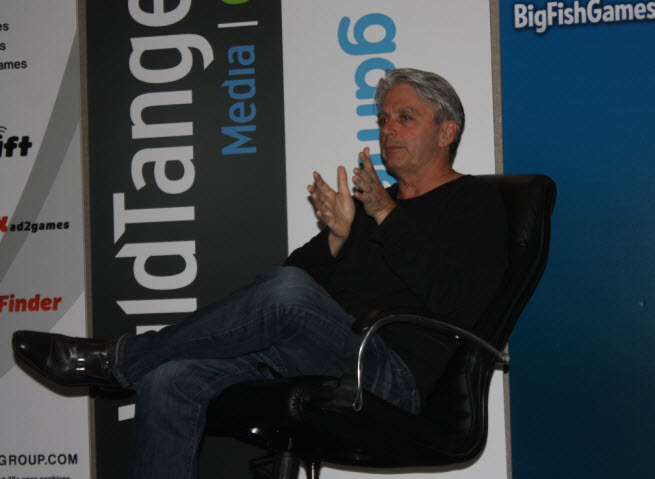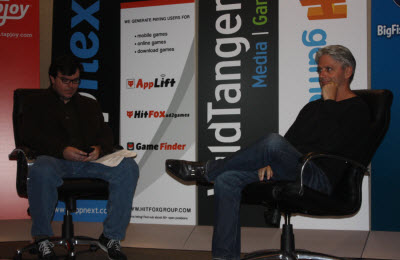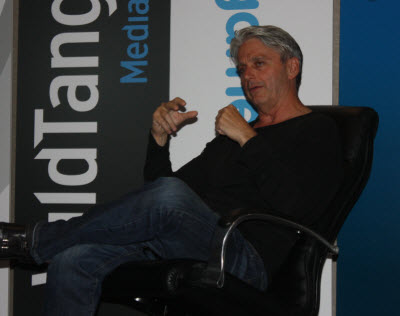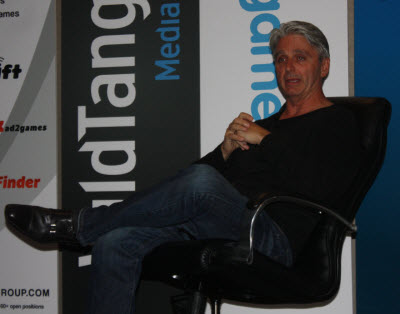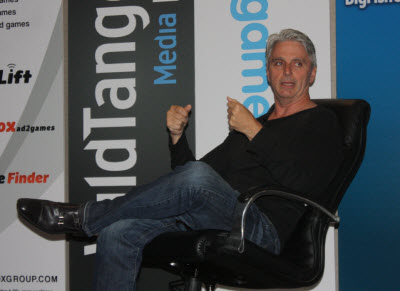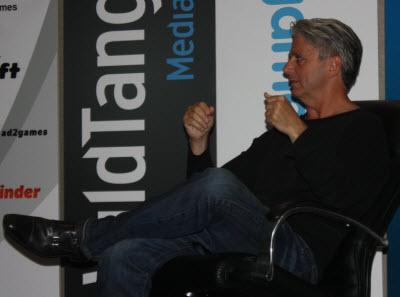John Riccitiello made his first extended speaking appearance this week at the Casual Connect game conference in San Francisco, revealing his views on the broader game industry for the first time since he resigned from Electronic Arts in February.
Riccitiello ran EA from 2007 to 2013 during a tumultuous time that included the rise of social games and the ascendancy of mobile gaming. He cut EA’s fat, expanded it with big acquisitions such as the $750 million purchase of PopCap Games in 2011, and then contracted again as he prepared the company for a transition to digital games. He put plans in place for the next-generation consoles and put EA on track to pursue Activision Blizzard’s flagship Call of Duty game with the Battlefield series. In this interview, Riccitiello revealed his post-EA opinions on the console transition, the role of publishers in mobile, and creating value in the game business.
Here’s a transcript of the interview between Riccitiello and game journalist Jon Gaudiosi.
John Gaudiosi: I wanted to start by getting your thoughts on the industry today. It seems like there are a few big winners in mobile – Supercell, Gung Ho, King, EA, Kabam — and everyone else trying to chase them. How do you see this evolving in the next year?
John Riccitiello: Like any form of media, there are players at the top of the charts. You named the five that are leaders globally today. One of the things that I found frankly shocking is how long titles stay in the top 50. Whether it’s Clash of Clans or DragonVale or some of these poker games or Candy Crush, they’re holding out for 100, 200, 300 days.
What I find fascinating is a couple of things. My first observation is that with the rarest of exceptions, no one’s gotten more than two games in the top 50. It’s one, it’s two. EA might have a few more than that. But it’s not a huge number of games in the top 50. Second thing that I’m noticing is that there’s almost nobody who has ever put up a mobile game that lasts longer than year in the top 50, and there’s never been a sequel that’s bigger than the first.
What that leads me to believe is that they’re either going to get lucky twice, or they’re going to have to figure out an answer that I think is vitally important for the health of the mobile business long term. Which is simply this: They need to build brands. Will Clash of Clans be with us in 25 years? This is Madden’s 25th anniversary. Will Candy Crush be around next summer, through the fabled IPO, and still be doing a couple of million dollars a day? Will they figure out how to do a 2.0? I see precious little going on right now in mobile to suggest that people are building multi-year franchises or multi-year brands.
Every form of media births some great brands. Digital animation brought us all of the great titles from Pixar. Originally animation brought us great brands like Mickey Mouse and Disney. Radio brought us CBS. Console gaming brought us EA, Nintendo, Activision, and brands like Call of Duty and Mario. What are going to be the great brands that the mobile players bring forth? I think we see them now, but right now — just in my judgment — you stop paying for a game or playing a game when you’re ready to throw your iPhone or your Android device through a window in frustration. You’ve been lifetime optimized so well that it can get pretty darn frustrating.
I’m waiting to see people figure out how to do that 2.0. Right now, we have those five super-talented companies. Others are going to challenge them. The big question for whether they stay at the top is whether they can get lucky again – which I wouldn’t bet on over and over again – or whether they can take their brands and make them sustain over multiple years, where consumers are familiar with the brand and they want to see it again. They want a 2.0 or a slightly different game. They’re expecting consistency on intellectual property and consistency on gameplay mechanics, plus fundamental improvement — newness, something different – that will bring them back over and over again.
Gaudiosi: When you look at the industry today, the top 50 titles seem to garner the vast majority of revenue in mobile. Will this trend continue?
Riccitiello: If you actually do the math, position number one is essentially a $1 billion business. Position 50 is about a $10 million business. It’s a pretty fast drop as you work from one to 50. Personally, I think that with mobile growing rapidly, we will see two billion-dollar brands at the top of the charts, a lot like console.
What’s going to be fascinating is that with all the increasing resources going into gaming, I’m betting that the 50th position will remain pretty close to that $10 million business. After you finish building the game, supporting the live team, paying for installs, and all the things you need to do, the bottom of the top 50 chart is going to be pretty close to breaking even.
In almost every form of media, we’re seeing a fight toward the top. The top movies get a much higher share of moviegoer dollars than ever before. The top television programs get a higher market share. At the World Cup or the Super Bowl, they’re getting record performances. Anything else is getting crushed. My belief is that the top 50 is where it’s at, and it’s going to be cutthroat.
Now we’re seeing a lot of me-toos. People are saying, “I’ll make Puzzle & Dragons, but make the circle into a diamond.” Or take Bejeweled and turn the jewels into fruit. Wouldn’t Clash of Clans be really cool if they were space invaders instead of Viking-ish? That level of innovation isn’t going to work from this point forward. We’ll only see a couple more shakes of that. Fundamental innovation is going to drive it, and realistically, the top 50 is going to be hard to crack, and it’s going to be where all the resources are. It’s going to become a go big or stay home market and stay that way.
Gaudiosi: Given that, is there a role for a scale publisher today in mobile?
Riccitiello: There was an announcement today, or I guess last night, about Facebook becoming a publisher in mobile. I think a lot of people can misunderstand publishing and what it is. For good or for bad, I had the pleasure of publishing about $50 billion worth of games. People have a concept in their mind of what publishers are, but publishers are actually pretty simple things.
They do three things. One, they provide capital to develop games with content creators. They don’t always provide capital, but providing capital is a key and valuable thing in the creation of content. That’s what Hollywood studios do, and that’s what game publishers have done for console and PC.
The second thing they do is they turn content into money. They are the point of transaction. Back in the retail days, they had 30,000 points of retail distribution, aggressive marketing, and plug-ins for television and advertising. Today, and I’m going to come back to that in a second, is there anybody operating as a publisher that actually converts content into money for the creator of the content?
The last thing they do is they provide an editorial service. In other words, they use some level of judgment based on past history as to what might work and might not work. Part of that is just the allocation of dollars, but sometimes it’s coaching or advice as to what might be more successful or not successful.
Both ends of the spectrum, if you will – the capital, the editing – are much the same, if you were to imagine yourself a publisher interacting with a developer. You can provide capital. You can choose where to apply it and what advice to give. I think the center section, around turning content into money, is a much more amorphous concept in a digital world. There are lots of players out there providing analytics, ad marketplaces. You have Facebook to provide connected users. But it doesn’t actually convert into meaningful revenue unless you have a product that generates daily revenue, that does that whole lifetime value thing that retains the consumer. A publisher cannot do that for a developer. A developer has to create a product that the user wants to come back and play every day.
I do believe that there will be people posing as publishers. Some people will be doing a lot of publishing value add. But in terms of being entirely responsible for converting content into revenue, I don’t think that’s going to exist in the same way. The developer needs to be involved in that process in a very significant way. Maybe someone will funnel users to them, but nobody else other than the developer can do the rest of the job. They need to make their product sticky. They need to make a product that people want to pay to play.
So I think there is going to be a different dividing line. I don’t know if the word “publisher” will be the best word to describe it. There will be people out there adding value in that scenario, but the full publisher concept seems to be less applicable than you might otherwise want to imagine.
Gaudiosi: Speaking of that added value, what opportunities are there today for mobile players doing ad marketplaces, analytics, and game engines?
Riccitiello: I’m going to jump through that question with an observation. If you look at the marketplace for stocks, Apple and Google. Since the advent of Android and the advent of iOS, these companies, between them, have added about $350 billion in market value. I would argue that at least half, if not tw-thirds of that, is directly a result of the mobile and tablet ecosystem they created. $300 billion in market value.
Now, all of you have heard the old saw about how content is king. Apple and Google aren’t great at content. They created a distribution platform for the content that most of you guys create, and they garnered $300 billion of value in doing so. Looking at the entire mobile ecosystem, you’ve gained your 70 or 75 percent of all the monetization on iOS and Android. The best I can come up with is that there might be $20 billion to $25 billion worth of shareholder value having been created on the other side of the equation, the side of the equation that is content. So arguably, it’s 10:1. Ten times more value has been created by a platform creator than has created by the content that goes over that. That wasn’t the case in console. It wasn’t the case in PC. It’s absolutely the case in mobile today.
I do think that there are smart players in that middle layer that will help developers monetize better – more rapidly, with more knowledge about their games. That is the key to righting the ship. There should be $100 billion or $200 billion or $300 billion worth of value on the other side of the equation. It won’t all go to games, but a big chunk of it needs to go to games.
In other words, as content developers, saying “content is king”? That’s a joke right now. Right now distribution is king. That’s where the money is being made. That’s where the value is being created. I think we can right that over time. We’re going to want to see these players in the middle be successful, because the alternative is that all those analytics, all that other stuff, will be entirely dependent on iOS and Android, and that’s a world where $400 billion worth of value gets created by the distributor, with very little left over for content creators.
From my vantage point, there’s a lot of value being added by everybody from a Unity, on the engine side, through the ad marketplaces like ChartBoost and the guys that do analytics in the middle, Contagion and many other companies. There’s a lot of value being added there. That needs to liberate the equity value that Apple and Google have soaked up and bring some of that more effectively to content developers.
Gaudiosi: What do you think the mobile industry can learn from console games?
Riccitiello: First off, mobile is growing at an infinitely better rate than console right now, so I’ll be careful on this point. But I visited with many mobile developers during the time I was at EA and in the time since I left EA about four months ago. One thing I’ve heard over and over again is, “We’re a mobile developer, a mobile content creator, but we’re going to bring console-level graphics to the mobile experience. That’s going to make us different and better. We’re going to hire people to do that.”
I think that’s a mistake. I go back to the time I was launching console and PC games. Investing in better graphics without figuring out what incremental or better differentiated gameplay goes with those graphics — in other words, rewarding the user with a better game, not just a prettier game – is a road to ruin. Prettier games cost more to make. Better games satisfy consumers.
If you go back to 1997 and 1998, a lot of game genres – RTS in particular, and some of the strategy games – all went to 3D. They doubled and tripled their development costs, but they didn’t fundamentally alter their gameplay. Revenue remained about the same. Development costs tripled. Everybody in the flight simulation business, the Jane’s type things and a few other guys in those businesses, RTS and so on, that hurt them really badly.
The companies that figured out how 3D would enable entirely new gameplay, these guys did really well. Action-adventure games, they weren’t really possible with sprites and isometric 2D types of game experiences. Going over to 3D sports games brought the same thing – fundamentally new game experiences.
If I were to come up with one bit of advice, as you’re looking at more powerful CPUs and GPUs in phones and tablets and you see that as an opportunity to create something that’s better-looking, think more about how that creates the opportunity to build an experience that you’ve not seen before, that is a different kind of gameplay. Some of them will be realtime gameplay mechanics. What do you unlock when you go to 3D, which is a lot more expensive to produce? What gameplay mechanic wasn’t possible before, or was fundamentally sub-optimized before? If you can answer that question, the investment is worth it. If you can’t answer that question, like the console folks before you, I think all you’ll find is that you spent more money to generate the same revenue. Eventually that doesn’t work very well.
Gaudiosi: If we were to flip that, what can the console industry learn from what’s going on in mobile?
Riccitiello: I’ll have two and a half answers to that. The first thing is, I spent a decade preaching simplicity and why we needed to make console games and PC games more accessible. I can say that we made this much progress, and it looks like a lot, but the progress we needed to make was a mile long. The console guys, with some exceptions, spent way too much time looking to the guy that writes the code and the marketing guy that plays the games as their target audience, and not recognizing that we were serving 200 million people in a world of 2 billion potential gamers. What got in the way was complexity.
Complexity and depth aren’t the same thing. I finished BioShock Infinite a couple of weeks ago. That’s a profoundly simple game to play. But it’s a profoundly deep game. It’s done very well. My point is that if we can learn anything for console and PC by looking at mobile, it’s radical simplification. Make it easy to get into. I don’t mean give up the depth, but make it simpler to access and get inside.
There are a lot of things I could say about how you can fashion business models. I would start by saying, though, that I don’t think microtransactions are going to be our only available model going forward. It’s clearly the dominant model in mobile right now, but remember – that has a game design question. In every mobile game that uses microtransactions as a business model, they’re also using microtransactions as a gameplay mechanic. You are managing resources as part of the game design. I don’t know if that’s the best business model for everything. I don’t know that I want to play a story-based game where I’m paying as I go as much as I do other types of games where I love to pay as I go.
I would say that the first thing is, console and PC guys should look at the model that’s going to make games accessible. But don’t mimic the business model to the point of slavery. It’s not going to be the only business model out there. The trends look like it, but it’s not going to end up that way.
Gaudiosi: When you look at casual gaming today, how different is the Facebook casual gaming experience compared to the mobile gaming experience?
Riccitiello: Let me start by saying I’m not entirely sure what a “Facebook gaming experience” really is. I play games on PC. I play games on my television through a console. I play games on touch devices – iPad and my Android phone. Each of those are very different. I think the most profound shift and driver in mobile is touch screens. Touch screens change an enormous number of things, and they aid in that simplicity I was talking about. It’s probably the biggest innovation in gaming since Atari – giving the consumer touch.
The ability to interact with the product in an intuitive way and getting rid of the complexity of a controller is a huge, huge thing. There have been a staggering number of great franchises built on that concept with new types of interfaces. Some very smart companies are taking games that used to work with controllers and keyboards and really thought that through. How to simplify and use the benefits of touch screens to yield a brand-new experience – companies that really thought that through have done very well. All you need to do is look at the top of the mobile charts to see who those companies are.
PC games, that’s my number one platform, for me personally. I love the keyboard and the mouse and the rest of it. I love the rich games that are played there. One of San Francisco’s companies, Kixeye, with their VEGA Conflict product, to me that’s a PC game. It plays like a PC game. It’s a great PC game. I’ve got all the assets that I’m building on one side and I’m going to war on the other. It’s a great PC game. I don’t know that it actually gets a lot from Facebook. At least from my perspective, there are touch-based mobile and tablet games, there are games that are best played on PC, and there are games that work well on a console. Games will go from device to device. I’m a Minecraft player, but I’ve never played it on console. I probably should. I just read that it made the top of the charts in the U.K., which means something is going on. I’m certainly missing something here.
But the question is, what does Facebook add in the middle for that? Historically, they’ve added a friends list and content discovery. Now, with Facebook Connect, we’re all using their discovery and friends list system, whether we’re on the platform or not. Right now they’ve announced their new mobile platform and what they’re going to do to try to support as a publisher. I think they need to do a better job of helping all of us understand what their value add is. Why is it better for a PC game to get it through Facebook? They’re blowing the numbers out and I’m sure they’re going to answer the question really well, but at least to me, it’s touch, PC, and console. The underlying hardware is the enabler for the type of game experience we can get. It’s very different to play a PC game, where the screen’s two feet in front of you, versus a TV, where it’s 15 feet in front of you. Screen resolution changes. Controllers change. But those are the three primary places that I look at.
Gaudiosi: I wanted to get your thoughts on how you see second-screen gaming impacting the business as we move forward with mobile.
Riccitiello: I’m now going to caution everybody that we should all collectively get a bottle of wine or a beer, because where I’m about to go is an area where no one really knows the answer. On the questions I’ve been asked so far, I feel like I have some advantage and a little bit of knowledge and I can say something. On this one I don’t really know.
I do know that I sit on my couch at home. I’m running Outlook on a PC over here looking at my e-mail. I’m playing a console game up on my TV. I might be playing Candy Crush on my tablet. I’m using multiple screens all the time. I think most of us are doing that in many different ways. I’ve seen some stupendous experiences with dual screens in console games, where you’re using a tablet or a phone as a secondary data input or just for information. The Nintendo DS was the first innovator there. But I don’t even know that we’re even scratching the surface as much as that we’re waving our hand over the surface that we’ve yet to scratch.
The concept of using the best screen in your house – the big TV – with your tablet or phone as a secondary input device or a data device or a touch device or a communication device is brilliant. Some of us may argue that all we’ll ever need is a tablet or a phone. You have HDMI wireless out into your television set. Your screen will be here, your controller will be there. That’s one example. Personally, I always found RTS on console impossible to play, because I need a second screen to figure it out. One of the reasons, in my view, that Command & Conquer didn’t do as well on console as it did on PC, or StarCraft didn’t do as well as it did on console as PC, is because you needed another data set. I would love to have my battle going on over here and move my troops over here as a gameplay idea. But again, I’m so far away, with that simple idea, from the many things we’re going to see.
The television is going to be used for mobile games going forward. I can’t tell you I know the exact mechanic. I can tell you that dual screen will be a really big idea, when you figure out a gameplay experience that is better when you’re using both.
VentureBeat's mission is to be a digital town square for technical decision-makers to gain knowledge about transformative enterprise technology and transact. Learn More
